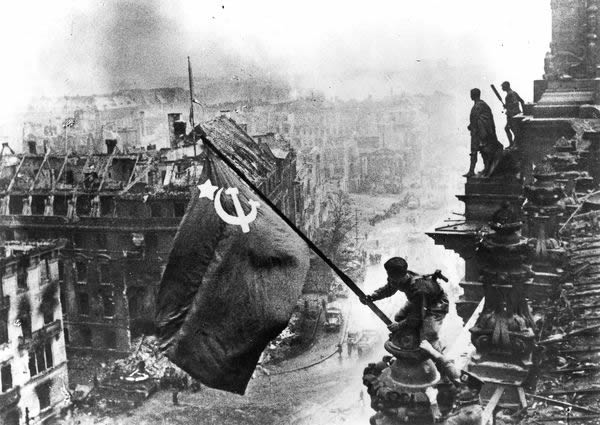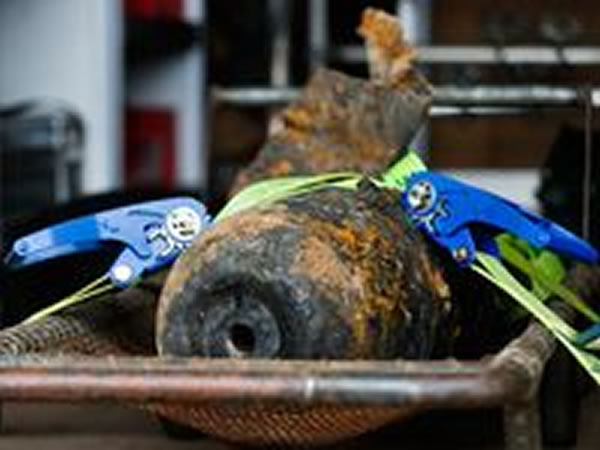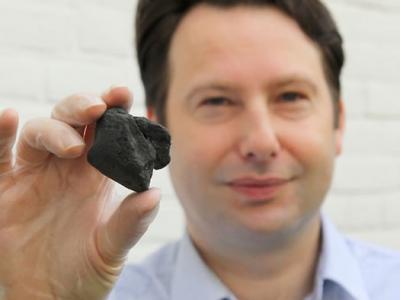Berlin Unexploded Bomb Shines Light on Buried Threat
Berlin traffic ground to a halt on Wednesday after a bomb was discovered 20 feet from a train track near the city's main station. Hundreds of people were evacuated from nearby hotels and apartments, schools in the area shut down as students were moved to safety, and planes were put in a holding pattern over the German capital for half an hour as a bomb squad gingerly defused the explosive device.
This was no terror incident, though. The 200-pound (91-kilo), 3-foot-long (1-meter-long) bomb was nearly 70 years old, dropped by a Soviet plane during the Second World War. Once its detonator was carefully removed, the TNT-packed iron tube was strapped to the bed of a truck and moved to a forest outside the city, where it could be safely detonated.
For most Berliners, the episode was more inconvenient than incredible. World War II bombs are part of life here, regularly turning up during construction projects and even in open fields and riverbeds. Dozens are discovered and defused each year.
Only the biggest make the news: In November 2011, the city of Koblenz evacuated 45,000 people—half its population, including two hospitals, seven retirement homes, and a prison—when a 4,000-pound (1,814-kilo) British bomb was found in the Rhine River.
Russian soldiers flying a flag made from table cloths over the ruins of the Reichstag in Berlin after storming the city. Unexploded bombs from sieges like this one still litter the German landscape.
The defused bomb. Photograph by Markus Schreiber, AP
And last year, a Munich neighborhood was rocked by an explosion when a bomb was detonated in place, covering several blocks in shards of glass from broken windows and setting roofs on fire.
Unlike the Munich explosion, Wednesday's incident was "a totally normal defusing," Berlin bomb squad head Dietmar Puepke told reporters at the scene.
Puepke has had a lot of practice, and experts predict he and other bomb disposal experts will get a lot more in the years to come. In the German capital, 2,000 bombs have been recovered since the end of the war. And experts say between 2,000 and 4,000 tons of explosive material—including unexploded hand grenades used during the fierce battle for the capital in 1945—still litter Berlin.
"They find and defuse 10 or 15 bombs each year," said Wolfgang Spyra, former head of the Berlin Police Department's Forensic Science and Engineering Department and a retired professor at Brandenburg Technical University in Cottbus. "At that rate, you can imagine how much longer the problem will be with us."
The number of bombs still to be found is staggering. British, American, and Russian bombing raids dumped upward of 2.7 million tons of bombs on Germany during the war, each weighing anywhere from 100 to 4,000 pounds (45 to 1,814 kilos). Spyra estimates between 7 and 15 percent of those were duds, bombs that hit the ground but failed to explode. For decades, they've remained live, waiting quietly for an errant backhoe or bulldozer to set them off.
Finding and removing them before the worst happens employs thousands of people in Germany, at a cost of tens of millions of dollars each year. Across Germany, an estimated 20,000 tons of WWII material—everything from bombs to rusty rifles and the wreckage of trucks and tanks—is recovered annually. The economic costs from offices, highways, and train lines being shut down while bomb squads do their work is incalculable.
Experts say the problem will get worse before it gets better. For decades, bombs turned up during postwar building projects, sometimes with deadly results. That's why construction projects in Germany today often require a Kampfmittelfreiheitsbescheinigung, or a permit certifying that the area is bomb-free, before work begins. Consultants pore over aerial photos from U.S. and British army archives for signs of unexploded ordnance.
But there are no guarantees, particularly in hard-hit cities like Berlin, the target of 363 air raids between May 1940 and April 1945. By the end of the war the city was a vast sea of rubble. "Bombs fell on train tracks, airfields, factories, and city centers," said Spyra.
As the years go by, remaining munitions get more dangerous: The material inside WWII-era bombs is usually TNT, a stable chemical that remains as explosive today as it was 70 years ago.
Allied bombs often included timers set to explode several hours to several days later, in order to kill firefighters or cleanup workers arriving at the scene of an air raid. "Naturally, that meant a long wait to get repairs started, which weakened the German military effort," said Spyra.
The dud detonators get more fragile with each passing year. The timers were commonly made of celluloid, a type of plastic that decays over time. (Many old movies were made of similar stuff, one reason many old movies no longer exist.) The deteriorating celluloid makes the detonators—and the bombs they arm—unpredictable and sometimes impossible to safely defuse.
Bombs have even been known to explode spontaneously: In Oranienburg, a town north of Berlin, five bombs have "self-detonated" since the late 1970s, and across Germany one or two bombs set themselves off each year.
As time goes on, Spyra predicts more and more bombs will be too unstable to disarm—and will have to be set off wherever they're found, potentially damaging or destroying nearby buildings or entire neighborhoods. "So far it's mostly been property damage, but I think we can also expect fatalities in the future."
Andrew Curry
for National Geographic News
Published April 4, 2013













